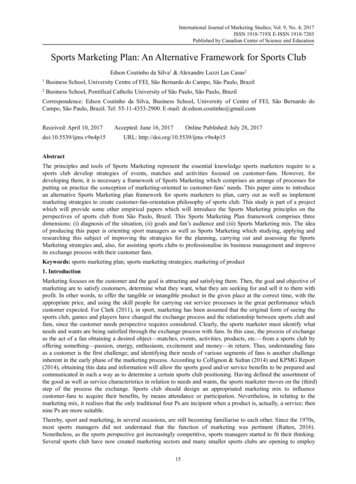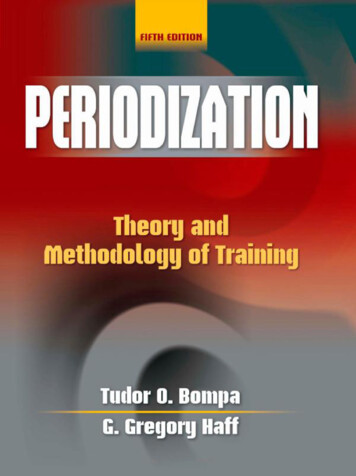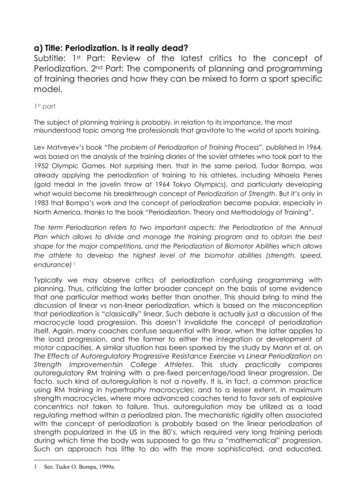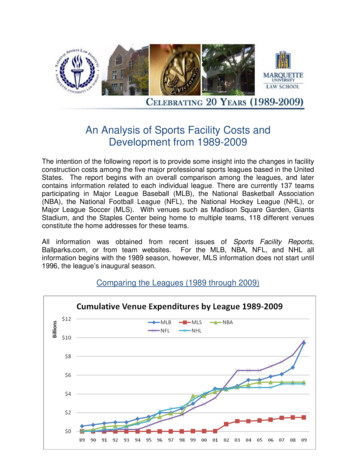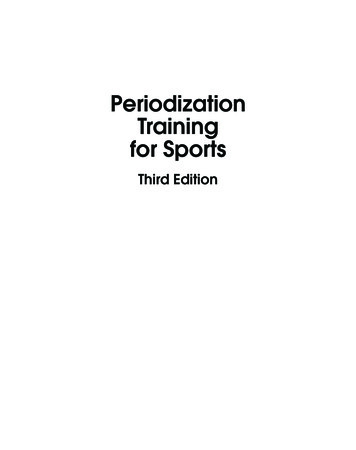
Transcription
PeriodizationTrainingfor SportsThird Edition
Library of Congress Cataloging-in-Publication DataBompa, Tudor O.Periodization training for sports / Tudor Bompa, Carlo Buzzichelli. -- Third Edition.pages cmPrevious edition was authored by Tudor O. Bompa and Michael Carrera.Includes bibliographical references and index.1. Periodization training. 2. Weight training. I. Buzzichelli, Carlo, 1973- II. Title.GV546.B546 2014613.7'13--dc232014014399ISBN: 978-1-4504-6943-2 (print)Copyright 2015 by Tudor O. Bompa and Carlo Buzzichelli 2005 by Tudor O. Bompa and Michael Carrera 1999 by Tudor O. BompaAll rights reserved. Except for use in a review, the reproduction or utilization of this work in any form or by any electronic, mechanical, or other means, now known or hereafter invented, including xerography, photocopying, and recording, and in any informationstorage and retrieval system, is forbidden without the written permission of the publisher.This publication is written and published to provide accurate and authoritative information relevant to the subject matter presented.It is published and sold with the understanding that the author and publisher are not engaged in rendering legal, medical, or otherprofessional services by reason of their authorship or publication of this work. If medical or other expert assistance is required, theservices of a competent professional person should be sought.The web addresses cited in this text were current as of October 2014, unless otherwise noted.Acquisitions Editor: Justin Klug; Developmental Editor: Laura Pulliam; Managing Editor: Elizabeth Evans; Copyeditor:Tom Tiller; Indexer: Dan Connolly; Permissions Manager: Martha Gullo; Graphic Designer: Julie L. Denzer; Cover Designer:Keith Blomberg; Photograph (cover): Yuri Arcurs/age fotostock; Photographs (interior): Human Kinetics, unless otherwisenoted; Photo Asset Manager: Laura Fitch; Photo Production Manager: Jason Allen; Art Manager: Kelly Hendren; AssociateArt Manager: Alan L. Wilborn; Illustrations: Human Kinetics, unless otherwise noted; Printer: McNaughton & GunnHuman Kinetics books are available at special discounts for bulk purchase. Special editions or book excerpts can also be created tospecification. For details, contact the Special Sales Manager at Human Kinetics.Printed in the United States of America 10 9 8 7 6 5 4 3 2 1The paper in this book is certified under a sustainable forestry program.Human KineticsWebsite: www.HumanKinetics.comUnited States: Human KineticsP.O. Box 5076Champaign, IL 61825-5076800-747-4457e-mail: humank@hkusa.comAustralia: Human Kinetics57A Price AvenueLower Mitcham, South Australia 506208 8372 0999e-mail: info@hkaustralia.comCanada: Human Kinetics475 Devonshire Road Unit 100Windsor, ON N8Y 2L5800-465-7301 (in Canada only)e-mail: info@hkcanada.comNew Zealand: Human KineticsP.O. Box 80Torrens Park, South Australia 50620800 222 062e-mail: info@hknewzealand.comEurope: Human Kinetics107 Bradford RoadStanningleyLeeds LS28 6AT, United Kingdom 44 (0) 113 255 5665e-mail: hk@hkeurope.comE6171
PeriodizationTrainingfor SportsThird EditionTudor Bompa, PhDCarlo A. BuzzichelliHUMANKINETICS
ContentsPrefaceAcknowledgmentsviixPart I Foundations of Strength Training1 Strength, Power, and MuscularEndurance in Sports2 Neuromuscular Response to StrengthTraining3193 Energy Systems Training374 Fatigue and Recovery595 Sport Nutrition736 Periodization as Planning andProgramming of Sport Training877 Laws and Principles of StrengthTraining for Sports99Part II Program Design8 Manipulation of Training Variables1259 The Microcycle Short-Term Plan15710 The Annual Plan175iv
Part III Periodization of Strength11 Phase 1: Anatomical Adaptation22912 Phase 2: Hypertrophy23913 Phase 3: Maximum Strength24914 Phase 4: Conversion to SpecificStrength26515 Phases 5, 6, and 7: Maintenance,Cessation, and Compensation311ReferencesIndexAbout the Authors335349357v
PrefaceThe market is saturated with strength training books, most of which are very traditionaland have no distinction from other strength training books. Nearly all discuss some basicphysiology, describe various exercises, and suggest a few training methods. Planning israrely discussed, and periodization (the structuring of training into phases) is seldommentioned simply because few authors understand its importance.Strength training is paramount in the development of athletes, but it must consist ofmore than just lifting weights without a specific purpose or plan. In fact, the purpose ofany strength training method should be to prepare athletes for competition—the idealtest of their skills, knowledge, and psychological readiness. To achieve the best results,athletes need to be exposed to a periodization program, or sport- and phase-specificvariations in training.This third edition of Periodization Training for Sports shows how to use periodizationin structuring a strength training program for athletes in various sports and specifieswhich training methods are best for each training phase. It also includes an expandedchapter on energy system training and suggests how to optimally integrate strengthtraining and metabolic training for various sports. The phases are planned according tothe competition schedule, and each has a specific goal for developing power or muscularendurance. The entire training program is aimed at achieving peak performance for themost important competitions of the year.This planning strategy, which we call periodization of strength, designates the type ofstrength to be developed in each training phase to ensure reaching the highest levels ofpower or muscular endurance. Developing the sport-specific abilities before the competitive phase is essential because they form the physiological foundation on which athleticperformance relies. The key element in organizing periodized strength training to developpower or muscular endurance is the sequence in which various types of strength trainingare planned.An objective of this book is to demonstrate that strength training is more than justlifting weights for its own sake. You must also be mindful of the goals of specific trainingphases and consider how to integrate strength training with sport-specific training todevelop motor potential and improve performance. This edition of Periodization Trainingfor Sports offers a method of reaching training objectives for competition through theuse of periodization. This book offers an in-depth look at structuring strength trainingprograms according to the physiological characteristics of the sport and the characteristics of the athlete. The book also challenges many methods of training currently beingused in sport training.Whatever your role in sport—strength coach, sport coach, instructor, personal trainer,athlete, or college student—you will benefit from this book by increasing your knowledge of periodization training and its physiological foundation. Once you apply thisconcept, you will know that it is the best way to organize a strength training programfor improving physiological adaptation, which ultimately produces better performance.Peak performance occurs because you plan for it!vi
The second edition of Periodization Training for Sports came out in 2005. This thirdedition represents the evolution derived from research and field work of the trainingmethodology since 2005. You will recognize the superiority of this method over thoseyou have used in the past. You will learn the following: The simple physiological concepts that enable the development of sport-specificstrength The abilities required for achieving performance goals for each sport, such as maximum speed, power, and muscular endurance The role of strength training in overall development of the physiological abilitiesrequired for reaching the highest possible level in various sports The concept of periodization and its specific application to strength training foryour sport The concept of energy system training and its integration with strength training foryour sport Actual methods of dividing the annual plan into strength training phases, each withspecific objectives How to develop several types of strength in a specific sequence to guarantee reachingthe highest levels of power or muscular endurance in a particular period of the year How to manipulate the loading patterns in each phase to create the specific physiological adaptations for reaching peak performancePart I (chapters 1 through 7) reviews the main theories influencing strength trainingand explains that power and muscular endurance are a combined physical quality. Italso explains why certain athletic movements require a certain type of strength and whysimply lifting weights will not benefit your performance.A successful strength training program depends on your level of knowledge in physiology of strength. The information in chapter 2, “Neuromuscular Response to StrengthTraining,” is presented simply so that people from all backgrounds can understand it.New to the third edition, a greatly expanded chapter 3, “Energy Systems Training,” usespractical examples to illustrate the integration of strength training and metabolic trainingfor various sports. The broader your knowledge in this area, the easier it will be to designprograms that result in the transfer of strength training benefits to sport-specific skills.Chapters 4 and 5 underscore the importance of recovery in strength training and containinformation on facilitating a faster recovery after workouts and maximization of trainingadaptations, especially through proper nutrition. Another addition to this book, chapter7 explains all the methodological concepts pertaining to the periodization of training;this enables you to analyze and design annual plans for various sports. Part I ends withan explanation of training principles and how they apply to strength training.vii
PrefacePart II (chapters 8 through 10) begins with a discussion of the elements in designinga strength training program, namely the manipulation of training variables and how itaffects training. Both short- and long-term planning, focusing mainly on weekly programsand the periodization of annual plans, are explained in detail to help you comprehendthis concept in training. A brief history of the concept of periodization is also presented.Part III, chapters 11 through 15, covers all the phases that make up the periodizationof strength. For each phase, the best training methods available for taking athletes to thehighest level are presented.In Periodization Training for Sports, you will find a more effective, more efficientmethod of training.viii
AcknowledgmentsWe express our sincerest thanks to the entire Human Kinetics team for their hard workand dedication in assembling the third edition of this book. Special thanks to Laura Pulliam, developmental editor, for her patience, advice, and understanding as we workedthrough implementing her many suggestions that resulted in a more logical and precisebook. Finally, this book is dedicated to all the coaches, exercise physiologists, trainers,and health and fitness professionals who strive to bridge the gap between the scienceand the practice of training.ix
This page intentionally left blank
PartIFoundations ofStrength Training
This page intentionally left blank
1Strength, Power,and MuscularEndurancein SportsAlmost all physical activities incorporate either force (or strength), speed, or flexibility—orsome combination of these elements. Strength exercises involve overcoming resistance;speed exercises maximize quickness and high frequency; endurance exercises involvelong distance, long duration, or many repetitions (reps); and flexibility exercises maximizerange of motion. Coordination exercises involve complex movements.Of course, the ability to perform certain exercises varies from athlete to athlete, andan athlete’s ability to perform at a high level is influenced by inherited (or genetic) abilities in strength, speed, and endurance. These abilities may be called conditional motorcapacities, general physical qualities, or biomotor abilities. Motor refers to movement, andthe prefix bio indicates the biological nature (the body) of these abilities.However, success in training and competition is not determined solely by an athlete’sgenetic potential. At times, athletes who strive for perfection in their training—throughdetermination and methodical planning of periodization—reach the podium or help theirteam win a major tournament. Although talent is extremely important, an athlete’s abilityto focus on training and to relax in competition can make the difference in his or herultimate achievement. To move beyond inherited strength or other genetic potential, anathlete must focus on physiological adaptation in training.Six Strength Training ProgramsAthletes and coaches in various sports use six main programs for strength training:bodybuilding, high-intensity training, Olympic weightlifting, power training throughoutthe year, powerlifting, and periodization of strength. Overall, however, periodization ofstrength is the most influential training methodology.3
Periodization Training for SportsBodybuildingBodybuilding is a creative sport in which the bodybuilder and trainer manipulate trainingvariables (such as sets, reps, rest periods, and speed of execution) to produce the highest level of exhaustion, followed by a period of rest and regeneration. Muscle size andstrength increase due to adaptations in the form of energy substrate overcompensationand muscle protein accretion.Bodybuilders are concerned chiefly with increasing their muscle size. To that end,they perform sets of 6 to 12 reps to exhaustion. However, increased muscle size is rarelybeneficial to athletic performance (the few exceptions may include younger or lower-levelathletes, American football players, and some performers in track-and-field throwingevents). More specifically, the
Bompa, Tudor O. Periodization training for sports / Tudor Bompa, Carlo Buzzichelli. -- Third Edition. pages cm Previous edition was authored by Tudor O. Bompa and Michael Carrera. Includes bibliographical references and index. 1. Periodization training. 2. Weight training. I. Buzzichelli, Carlo, 1973- II. Title. GV546.B546 2014 613.7'13--dc23 2014014399
